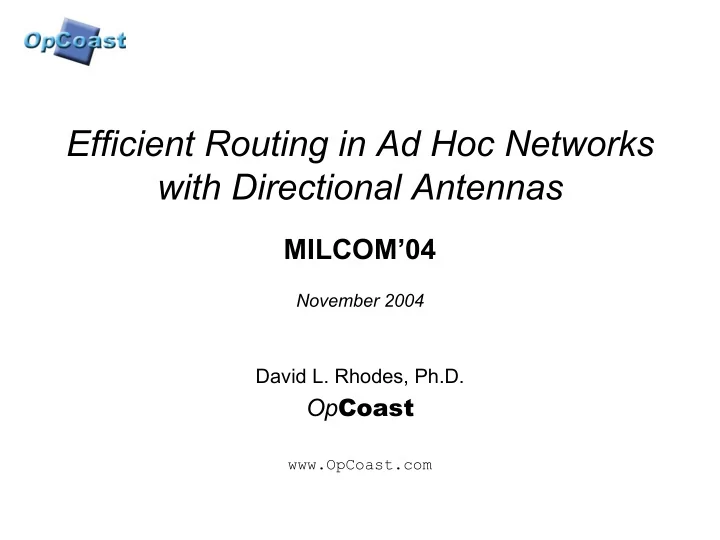

Efficient Routing in Ad Hoc Networks with Directional Antennas MILCOM’04 November 2004 David L. Rhodes, Ph.D. Op Coast www.OpCoast.com
The Problem Electrically Steerable Antenna Network Links: Depend on antenna pointing !
Some Details – Pairwise States to Metrics v X v Y Node 6, State Node 1, State Metric # antenna states squared v6 -> v1 v X → v Y E W N S E W N S v 2 v 5 ∞ 1 1 1 1 1 1 1 1 ∞ 1 1 ∞ 1 1 ∞ 1 1 v y v x ∞ 1 1 ∞ 1 1 Different ∞ 1 1 Directional ∞ Metrics & 1 1 Node ∞ 1 1 connectivity Antenna ∞ 1 1 for each Gain Pattern ∞ 1 1 state v 4 State 1 ∞ 1 1 State 2 ∞ 1 1 State 3 ∞ 1 1 State 4 Edge metric = {1, ∞ } ∞ = disconnected
How many antenna states are there? For a pair of nodes, there are m 2 combinations of antenna Directional Directional Tx Number Antenna states, there are ( n 2 - n ) pairs Tx / Rx / Omni Rx nodes Directions in the network ( n ) ( m ) m 2 ( n 2 - n ) m ( n 2 - n ) Errata in paper! 2 m should be m 2 v 1 v 2 2 4 32 8 m 2 ( n 2 - n )/2 if symmetric v 1 v 2 3 3 54 18 v 3 20 4 6,080 1,520 Larger Network 40 8 99,840 12,480 Tractable
Overall Solution Steps • Step 1 : Analyze antenna states to form multi-state network – Involves propagation and radio parameters, or sensing • Step 2 : Find all routes in multi-state network efficiently – Need efficient method to combat combinatorial explosion • Step 3 : Map multi-state network routing solution back to antenna state settings – With solution in hand, determine antenna direction settings Multi-state networks are new
MSD-SPA Algorithm v 2 • The Multi-State, Dynamic Shortest Path 8 , ∞ 5, ∞ Algorithm uses dynamic programming and only finds solutions for ‘dominant states’ v 4 v 1 7 , ∞ – Dominant State - A particular setting of edge metrics, including don’t care settings, 10 , ∞ 1 , ∞ v 3 is called dominant if and only if altering any edge metric setting(s) will change the shortest reachable distance from s to some vertex and where the state is not in turn dominated by another dominant state. – Dominant Set - The dominant set of dominant states is the set of dominant states such that the associated graph is ‘covered,’ meaning that any possible graph state can be matched to a member in the dominant set. This is a dominant set for the sample, 2 5 = 32 states are covered with only 9 dominant states
MSD-SPA Algorithm initialize 2: Select e min 4&5: If higher metric value for e min available, create copy of solution and use higher value, recurse in step 7 Otherwise step 8: select e min and set distances and nodes reached ( Q )
Resulting Multistate Network After analyzing antenna states to form connectivity or edge metrics – we get a multi-state graph The ‘1 , ∞ ’ comes from various v 1 and v 5 pairwise antenna settings. The 1 is for connected the ∞ is disconnected here, but actual quality metrics can be used as well. Here, four directional antenna nodes give rise to thirteen bi-directional arcs that have two states {1, ∞ } each giving rise to 2 26 = 67,108,864 combinatorial states in the multistate graph. 2 26 = 67,108,864 states are covered with only Untractable for brute force method, but … 836 dominant states for v 8 as source
Final Steps Use multi-state graph solution to find antenna direction settings Consider routing from node v 8 to v 3 • Three dotted lines are the all the minimum length routes. Step 1: Select one of three routes of cost ‘3’ found from v 8 to v 3 – dotted lines. Suppose we pick the lower route Step 2: determine possible antenna states at each node that correspond to desired metrics Dotted lines will be the minimum e.g. v 4 may be pointed ‘up’ for v 6 length routes found by MSD-SPA connectivity
Quality metrics above connectivity metrics Radio Connection Edges Node v 1 v 2 Edge metrics = 1/2 b , 1/ b, ∞ Data rates = 0, b , 2 b a) b) Multistates can include more than just {1, ∞ } and reflect QoS of the link in various states Fig. 4.Multi-metric edge states may arise from radios capable of adaptable data rates. In a) two radios are capable of bi- • For example, a high-rate connection may be available when Rx/Tx antennas are directionally communicating at different rates and b) the graph equivalent. both pointed together, otherwise a medium rate might be achieved or no connection at all.
Summary and Future Work Don’t settle for sub-optimal solutions • New and efficient means for determining network-wide antenna state settings for routing – Uses multiple link-states derived from propagation analysis or from real-time probing of the media • A node can use a control frame to switch through its antenna states while checking for connectivity or QoS level on the link – Method is ‘complete’ or optimal in that all multistate routes are efficient discovered in the form of a dominant set that covers the graph • Multiple solutions (antenna settings) can be found to satisfy a route • Future: – Use the MSD-SPA computation method within the context of an ad hoc routing protocol • Perhaps tie in with DSR route responses or other protocols • Couple into actual antenna control – Further investigate final route selection process and complexity Errata: goto www.OpCoast.com navigate to ‘Downloads’ then ‘Documents’ to find corrected paper
Recommend
More recommend